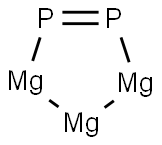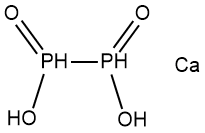Magnesium phosphide
- CAS NO.:12057-74-8
- Empirical Formula: Mg3P2
- Molecular Weight: 134.86
- MDL number: MFCD00049484
- EINECS: 235-023-7
- SAFETY DATA SHEET (SDS)
- Update Date: 2024-12-18 14:08:52

What is Magnesium phosphide?
Description
Magnesium phosphide has the formula of Mg3P2 and
themolecularweight of 134.9456 g/mol.It is a yellow
cubic crystal having a density of 2.06 g/cm. It reacts
violently with water and may ignite upon contact with air. It is toxic by ingestion. It has a slight odor of garlic.
It is not combustible but forms a flammable gas on
contact with water or damp air:
Mg3P2 (solid) + 6H2O (liq)?3Mg(OH)2 (solid)
+ 2PH3 (gas)
Mg3P2 burns in air or oxygen at a dull red heat to form
a phosphate, and reacts with chlorine gas to form:
Mg3P2 (solid) + Cl2?MgCl2 + PCl3
Chemical properties
shiny grayish yellow; stable in dry air; decomposed by moisture; can be prepared directly from magnesium and phosphorus; used with igniting agent such as 1% HNO3 in sea flares [KIR82]
The Uses of Magnesium phosphide
Magnesium phosphide has found several uses in
industry. It reacts with moisture in the atmosphere to
produce phosphine gas which is the substance that is active as a pesticide to control insects and rodents. It is
primarily used for indoor fumigation of raw agricultural
commodities, animal feeds, processed food commodities,
and nonfood commodities in sealed containers or
structures, and for outdoor fumigation of burrows to
control rodents and moles in nondomestic areas, noncropland,
and agricultural areas. Aluminum and
magnesium phosphide are formulated as tablets, pellets,
impregnated materials and dusts. Aluminum and
magnesium phosphide are restricted use chemicals.
With magnesium
phosphide, a fumigant is available which can be
used for fumigating tobacco even at low temperatures.Magnesium phosphide treatment of dried-fig stacks
at 600 and 1000 ppm phosphine for 3 days under
tarpaulin were compared with the standard method of
control, Methyl bromide. The tested concentrations
and exposure periods for Mg3P2 provided 100%
mortality in test insects and no negative effect on fruit
quality for 9 months in storage under ambient conditions.
In contrast, fruit quality with CH3Br did not match
that of PH3-treated fruit.
Magnesium phosphide has also been used to control
insects in stored almonds, barley, brazil nuts, cashews,
cocoa beans, coffee beans, corn, cottonseed, dates, filberts,
flower seed, grass seed,millet,oats, peanuts, pecans, pistachio
nuts, popcorn, rice, rye, sorghum, soybeans,
sunflower seed, triticale, walnuts, wheat, vegetable seed,
animal feed or feed ingredients.
General Description
Magnesium phosphide is a white crystalline solid. Magnesium phosphide reacts violently with water and may ignite upon contact with air. Magnesium phosphide is toxic by ingestion. Magnesium phosphide is used to make other chemicals.
Air & Water Reactions
Decomposed by water or moisture in air evolving toxic phosphine and diphosphine, that often ignites [Douda 1966]. May ignite upon contact with air.
Reactivity Profile
Magnesium phosphide is a strong reducing agent. Nitric acid oxidizes Magnesium phosphide with incandescence [Mellor 8:842. 1946-47]. Magnesium phosphide ignites on heating with chlorine, bromine, or iodine vapors, [Mellor, 1940, Vol. 8, 842]. Magnesium phosphide reacts vigorously with most oxidants.
Magnesium phosphide and Magtoxin have not been reported as flammable chemical substances. However, they react readily with water to produce hydrogen phosphide (phosphine, PH3) gas, which may ignite spontaneously in air. Magnesium phosphide is stable to most chemical reactions, except for hydrolysis. Magtoxin, Fumi-Cel, and Fumi-Strip will react with moist air, liquid water, acids, and some other liquids to produce toxic and flammable hydrogen phosphide gas. Magnesium phosphide is more reactive than aluminium phosphide and will liberate hydrogen phosphide more rapidly and more completely at lower temperatures and humidities. Magnesium phosphide is not combustible but forms flammable gas on contact with water or damp air. Magnesium phosphide gives off irritating or toxic fumes (or gases) in a fire and on contact with water or damp air may cause explosion hazard.
Health Hazard
Highly toxic: contact with water produces toxic gas, may be fatal if inhaled. Inhalation or contact with vapors, substance or decomposition products may cause severe injury or death. May produce corrosive solutions on contact with water. Fire will produce irritating, corrosive and/or toxic gases. Runoff from fire control may cause pollution.
Fire Hazard
Produce flammable and toxic gases on contact with water. May ignite on contact with water or moist air. Some react vigorously or explosively on contact with water. May be ignited by heat, sparks or flames. May re-ignite after fire is extinguished. Some are transported in highly flammable liquids. Containers may explode when heated. Runoff may create fire or explosion hazard.
Safety Profile
A poison. Flammable when exposed to heat, flame, or oxidizing materials. Ignites when heated in chlorine, bromine, or iodine vapors. Incandescent reaction with nitric acid. Reacts with water to evolve flammable phosphme gas. When heated to decomposition it emits toxic fumes of POx and phosphine. See also MAGNESIUM and PHOSPHIDES.
Properties of Magnesium phosphide
| Melting point: | 750 °C |
| Density | 2.060 |
| solubility | reacts with H2O |
| form | yellow cubic crystals |
| color | yellow cubic crystals, crystalline |
| Water Solubility | decomposed by H2O [KIR82] |
| EPA Substance Registry System | Magnesium phosphide (12057-74-8) |
Safety information for Magnesium phosphide
| Signal word | Danger |
| Pictogram(s) |
 Skull and Crossbones Acute Toxicity GHS06 |
| GHS Hazard Statements |
H227:Flammable liquids H315:Skin corrosion/irritation H319:Serious eye damage/eye irritation |
| Precautionary Statement Codes |
P210:Keep away from heat/sparks/open flames/hot surfaces. — No smoking. P261:Avoid breathing dust/fume/gas/mist/vapours/spray. P264:Wash hands thoroughly after handling. P264:Wash skin thouroughly after handling. P270:Do not eat, drink or smoke when using this product. P271:Use only outdoors or in a well-ventilated area. P280:Wear protective gloves/protective clothing/eye protection/face protection. P305+P351+P338:IF IN EYES: Rinse cautiously with water for several minutes. Remove contact lenses, if present and easy to do. Continuerinsing. P332+P313:IF SKIN irritation occurs: Get medical advice/attention. P337+P313:IF eye irritation persists: Get medical advice/attention. P370+P378:In case of fire: Use … for extinction. P405:Store locked up. P403+P233:Store in a well-ventilated place. Keep container tightly closed. P403+P235:Store in a well-ventilated place. Keep cool. |
Computed Descriptors for Magnesium phosphide
New Products
Tert-butyl bis(2-chloroethyl)carbamate (S)-3-Aminobutanenitrile hydrochloride N-Boc-D-alaninol N-BOC-D/L-ALANINOL N-octanoyl benzotriazole 3-Morpholino-1-(4-nitrophenyl)-5,6-dihydropyridin- 2(1H)-one Furan-2,5-Dicarboxylic Acid Tropic acid Fmoc-Val-Cit-PAB DIETHYL AMINOMALONATE HYDROCHLORIDE 1,1’-CARBONYLDIIMIDAZOLE R-2-BENZYLOXY PROPIONIC ACID 1,1’-CARBONYLDI (1,2-4 TRIAZOLE) N-METHYL INDAZOLE-3-CARBOXYLIC ACID (2-Hydroxyphenyl)acetonitrile 4-Bromopyrazole 5-BROMO-2CYANO PYRIDINE 5-broMo-2-chloro-N-cyclopentylpyriMidin-4-aMine 2-(Cyanocyclohexyl)acetic acid 4-methoxy-3,5-dinitropyridine 2-aminopropyl benzoate hydrochloride 1-(4-(aminomethyl)benzyl)urea hydrochloride tert-butyl 4- (ureidomethyl)benzylcarbamate diethyl 2-(2-((tertbutoxycarbonyl)amino) ethyl)malonateRelated products of tetrahydrofuran








You may like
-
 2033-24-1 98%View Details
2033-24-1 98%View Details
2033-24-1 -
 1975-50-4 98%View Details
1975-50-4 98%View Details
1975-50-4 -
 2-HYDROXY BENZYL ALCOHOL 98%View Details
2-HYDROXY BENZYL ALCOHOL 98%View Details
90-01-7 -
 2-Chloro-1,3-Bis(Dimethylamino)Trimethinium Hexafluorophosphate 221615-75-4 98%View Details
2-Chloro-1,3-Bis(Dimethylamino)Trimethinium Hexafluorophosphate 221615-75-4 98%View Details
221615-75-4 -
 61397-56-6 CIS BROMO BENZOATE 98%View Details
61397-56-6 CIS BROMO BENZOATE 98%View Details
61397-56-6 -
 14714-50-2 (2-Hydroxyphenyl)acetonitrile 98+View Details
14714-50-2 (2-Hydroxyphenyl)acetonitrile 98+View Details
14714-50-2 -
 118753-70-1 98+View Details
118753-70-1 98+View Details
118753-70-1 -
 733039-20-8 5-broMo-2-chloro-N-cyclopentylpyriMidin-4-aMine 98+View Details
733039-20-8 5-broMo-2-chloro-N-cyclopentylpyriMidin-4-aMine 98+View Details
733039-20-8